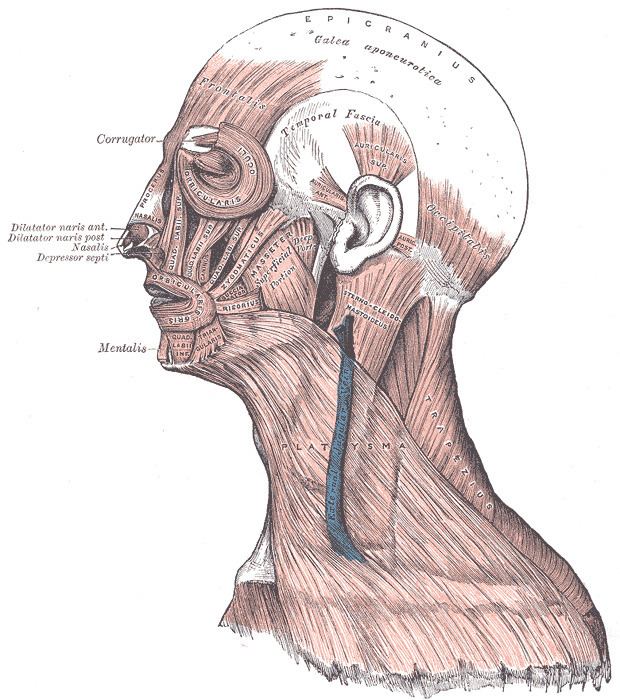Dorlands/Elsevier m_22/12548981 FMA 71288 | Latin musculi faciei TA A04.1.03.001 | |
 | ||
The facial muscles are a group of striated skeletal muscles innervated by the facial nerve (cranial nerve VII) that, among other things, control facial expression. These muscles are also called mimetic muscles.
Contents
Structure
The facial muscles are subcutaneous (just under the skin) muscles that control facial expression. They generally originate from the surface of the skull bone (rarely the fascia), and insert on the skin of the face. When they contract, the skin moves. These muscles also cause wrinkles at right angles to the muscles’ action line. Use of these muscles is noted during an extraoral examination, assuring function of the nerve to these muscles.
Innervation
The facial muscles are innervated by facial nerve (cranial nerve VII), with each nerve serving one side of the face. In contrast, the nearby masticatory muscles are innervated by the mandibular nerve, a branch of the trigeminal nerve (cranial nerve V).
Development
The facial muscles are derived from the second branchial/pharyngeal arch.
List of muscles
The facial muscles include:
The platysma is innervated by the facial nerve. Although it is mostly in the neck and can be grouped with the neck muscles by location, it can be considered a muscle of facial expression due to its common innervation.
The stylohyoid muscle, stapedius and posterior belly of the digastric muscle are also innervated by the facial nerve, but are not considered muscles of facial expression.
Clinical relevance
An inability to form facial expressions on one side of the face may be the first sign of damage to the nerve of these muscles. Damage to the facial nerve results in facial paralysis of the muscles of facial expression on the involved side. Paralysis is the loss of voluntary muscle action; the facial nerve has become damaged permanently or temporarily. This damage can occur with a stroke (cerebrovascular accident or CVA), Bell palsy, or parotid salivary gland cancer (malignant neoplasm) because the facial nerve travels through the gland. The parotid gland can also be damaged permanently by surgery or temporarily by trauma. These situations of paralysis not only inhibit facial expression but also seriously impair the patient’s ability to speak, either permanently or temporarily.
